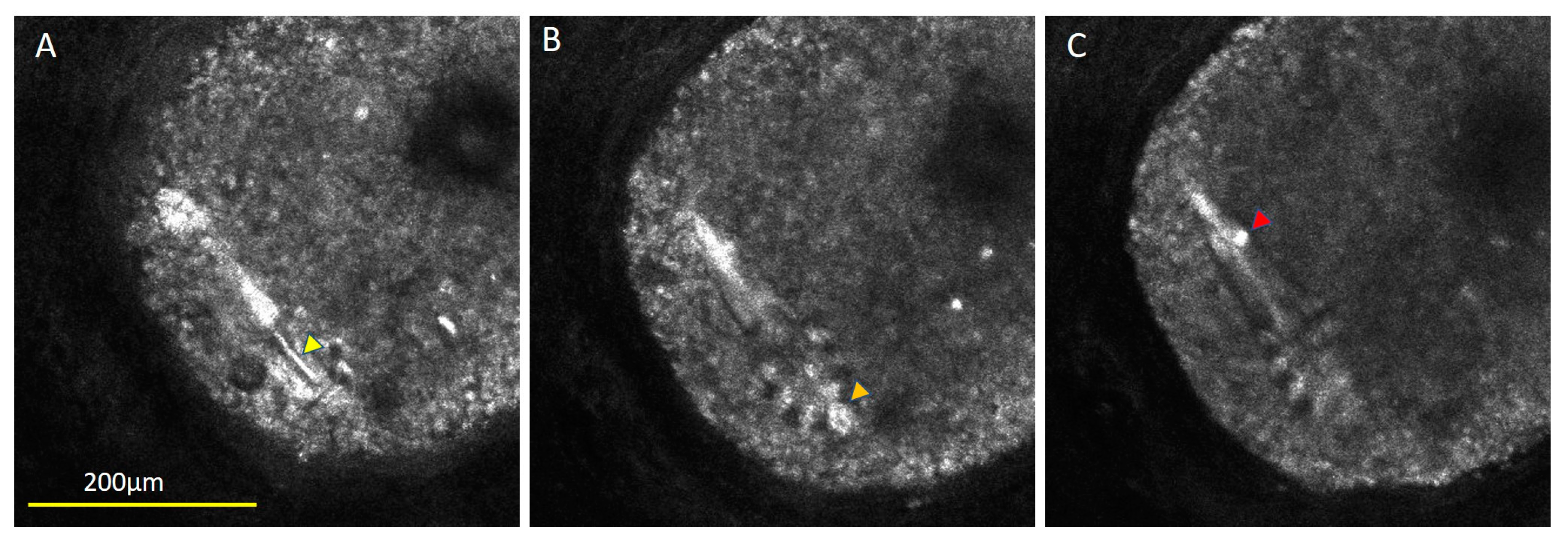In Vivo View of a Reclining Demodex Mite in a Milia Cyst
Abstract

Author Contributions
Funding
Institutional Review Board Statement
Informed Consent Statement
Data Availability Statement
Conflicts of Interest
References
- Elston, C.A.; Elston, D.M. Demodex mites. Clin. Dermatol. 2014, 32, 739–743. [Google Scholar] [CrossRef] [PubMed]
- Thoemmes, M.S.; Fergus, D.J.; Urban, J.; Trautwein, M.; Dunn, R.R. Ubiquity and diversity of human-associated Demodex mites. PLoS ONE 2014, 9, e106265. [Google Scholar] [CrossRef] [PubMed]
- Nazzaro, G.; Farnetani, F.; Moltrasio, C.; Passoni, E.; Pellacani, G.; Berti, E. Image gallery: Demodex folliculorum longitudinal appearance with reflectance confocal microscopy. Br. J. Dermatol. 2018, 179, e230. [Google Scholar] [CrossRef] [PubMed]
- Slutsky, J.B.; Rabinovitz, H.; Grichnik, J.M.; Marghoob, A.A. Reflectance confocal microscopic features of dermatophytes, scabies, and demodex. Arch. Dermatol. 2011, 147, 1008. [Google Scholar] [CrossRef] [PubMed]
- Ribeiro, A.E.; Paschoal, F.M. Reflectance confocal microscopy enabling full viewing of Demodex sp. Int. J. Dermatol. 2020, 59, 1020–1021. [Google Scholar] [CrossRef]
Disclaimer/Publisher’s Note: The statements, opinions and data contained in all publications are solely those of the individual author(s) and contributor(s) and not of MDPI and/or the editor(s). MDPI and/or the editor(s) disclaim responsibility for any injury to people or property resulting from any ideas, methods, instructions or products referred to in the content. |
© 2023 by the authors. Licensee MDPI, Basel, Switzerland. This article is an open access article distributed under the terms and conditions of the Creative Commons Attribution (CC BY) license (https://creativecommons.org/licenses/by/4.0/).
Share and Cite
Hanlon, K.; Thomley, M.; Correa-Selm, L. In Vivo View of a Reclining Demodex Mite in a Milia Cyst. Diagnostics 2023, 13, 1718. https://doi.org/10.3390/diagnostics13101718
Hanlon K, Thomley M, Correa-Selm L. In Vivo View of a Reclining Demodex Mite in a Milia Cyst. Diagnostics. 2023; 13(10):1718. https://doi.org/10.3390/diagnostics13101718
Chicago/Turabian StyleHanlon, Katharine, Meredith Thomley, and Lilia Correa-Selm. 2023. "In Vivo View of a Reclining Demodex Mite in a Milia Cyst" Diagnostics 13, no. 10: 1718. https://doi.org/10.3390/diagnostics13101718
APA StyleHanlon, K., Thomley, M., & Correa-Selm, L. (2023). In Vivo View of a Reclining Demodex Mite in a Milia Cyst. Diagnostics, 13(10), 1718. https://doi.org/10.3390/diagnostics13101718




